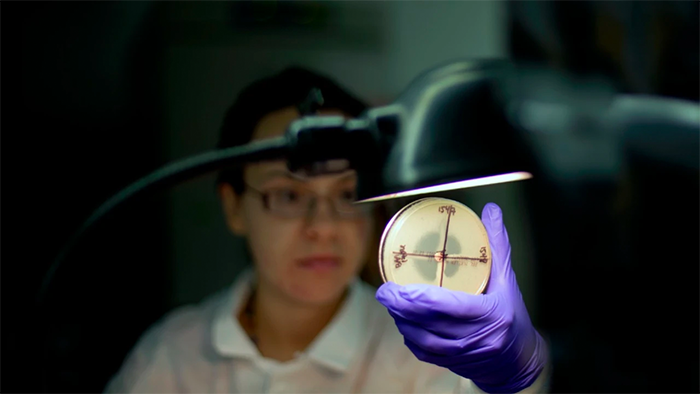Addressing Antimicrobial Resistance—The Invisible Pandemic
As cases of COVID-19 begin to recede due to the combination of public health guidance and novel medical countermeasures, health officials will need to shift gears to address the pandemic lying in wait: antimicrobial resistance (AMR). Nearly three million cases and more than 35,000 deaths in the United States are attributed to drug-resistant infections annually. Distressingly, the pandemic threatens to reverse recent progress against AMR. Emerging evidence about Americans hospitalized for COVID-19 between February and July 2020 indicates that more than half of patients received at least one and more than a third of patients received multiple antimicrobials. Such high rates of antimicrobial prescribing are discordant with the low rate of associated bacterial pneumonia (20 percent). Electronic health records analysis indicates that 82 percent of these prescriptions were ordered at admission—and therefore potentially before infection could be confirmed—which is counter to the stewardship practices needed to prevent AMR. Similar trends have been observed globally; for example, the World Health Organization (WHO) reported 75 percent of severe COVID-19 patients in Europe were receiving antimicrobials despite antibacterial coinfection rates of 15 percent.
Like COVID-19, the best medicine for AMR is prevention, from regimen adherence to stewardship to improved pathogen surveillance. However, the high burden of morbidity and mortality in the present and risk of increasing drug resistance in the future require a parallel focus on developing new medical countermeasures. Yet, the pipeline of antimicrobial innovations has long run dry due to market failures, misaligned incentives, and barriers for clinical trials. Public health officials faced similar challenges for COVID-19 and relied on unprecedented public-private partnerships to streamline the discovery and delivery of novel diagnostics, therapeutics, and vaccines. In this blog post, we outline how the operational and regulatory structures developed during COVID-19 represent a scalable model to accelerate biomedical innovation for AMR.
Barriers To Antibiotic Innovation
The scarcity of new antimicrobial drugs can be attributed to three issues. First, researchers face barriers to patient recruitment in clinical trials. For example, there may be limited populations for specific pathogens, and it may be challenging to identify viable trial sites due to variation in infection prevalence. Likewise, antimicrobials for drug-resistant infections are generally validated first in critically ill patients, for whom the urgent need to initiate empiric therapy following infection identification narrows the window for recruitment. Second, the clinical pipeline lacks therapeutic diversity, with the WHO’s most recent review indicating that only six of the 32 antimicrobials in development for priority pathogens are considered “innovative” (for example, new class, new target). Third, the business case for new antimicrobials—which are typically intended for use only after first- and second-line treatments have failed—is fundamentally at odds with the paradigm of volume-based reimbursement. For example, the biotech firm Achaogen, which received nearly $150 million in funding from the US government, filed for bankruptcy after its antimicrobial registered less than $1 million in sales in the first year following US marketing authorization. Such prominent commercial failures illustrate the misalignment of financial incentives, resulting in waning investment.
Policy makers have sought to address AMR through legislation, regulatory guidance, and payment reform. For example, the Generating Antibiotic Incentives Now Act of 2012 established the Qualified Infectious Disease Product (QIDP) designation, with nearly 150 designations awarded and a dozen ensuing approvals granted during the program’s first five years. Likewise, the Food and Drug Administration (FDA) finalized guidance in 2020 on the Limited Population Pathway for Antibacterial and Antifungal Drugs (LPAD), a regulatory corridor that has supported the authorization of two antimicrobials to date. Furthermore, the Centers for Medicare and Medicaid Services (CMS) in 2019 developed an alternative New Technology Add-On Payment pathway for QIDP-designated antimicrobial drugs (later expanded for LPAD-designated products) and adjusted cost codes for drug-resistant infections. Yet, in spite of these initiatives, antimicrobial research continues to exhibit lengthening development timelines, declining success rates, and receding industry sponsorship, illustrating the need for systemic reform.
Lessons From COVID-19
The market failures and technical challenges for antimicrobials were put in perspective during the COVID-19 pandemic. For example, vaccine development, such as antimicrobial drugs, has generally been deprioritized as existing payment systems do not fully capture the public health value of such products. Likewise, the complexities of treating COVID-19, including timing of treatment and management of complications, are analogous to the challenges of designing trials for drug-resistant infections. Consequently, the unprecedented federal investments and new public-private partnerships established for the current pandemic may provide a template for accelerating antimicrobial innovation.
First, the portfolio approach used for COVID-19 could inform early capital formation for antimicrobials. Given the exigency of the pandemic, the government developed triaging mechanisms, such as the National Institutes of Health’s (NIH’s) COVID-19 Clinical and Preclinical Candidate Portal and the FDA’s Coronavirus Treatment Acceleration Program, to inventory therapeutic candidates and expedite clinical trial initiation. Similarly, Operation Warp Speed financed vaccine candidates with different platform technologies to increase the likelihood of success. Policy makers should use this model to diversify antimicrobial drug development. The federal government’s Task Force on Combating Antibiotic-Resistant Bacteria should conduct a structured review of the 407 antimicrobial agents currently in preclinical development and work with the NIH and the Biomedical Advanced Research and Development Authority to prioritize financing and development. Such steps would better position the US government to fulfill the goals of the new five-year AMR National Action Plan.
Second, pandemic-era innovations in clinical trial design should help address longstanding barriers to antimicrobial drug development. The NIH’s Accelerating COVID-19 Therapeutic Interventions and Vaccines (ACTIV) public-private partnership developed master protocols for specific research themes (for example, immune modulators, antithrombotics) and leveraged existing clinical trial networks to ensure studies had sufficient power and that data was shareable for rapid evaluations. Regulators should leverage this infrastructure to scale antimicrobials trials, which are frequently limited to non-inferiority studies due to the challenges for accruing adequate sample sizes. For example, the FDA and the NIH could collaborate to develop master protocols for antimicrobial drugs and use recommendations from the European Union’s public-private partnership for AMR, COMBACTE-NET. Likewise, lessons from ACTIV could inform an expansion of the Antibacterial Resistance Leadership Group, an NIH-funded clinical trials network for AMR coordinated by the Duke Clinical Research Institute. The Wellcome Trust estimates that an AMR clinical trials network would reduce trials costs by 23 percent, with complicated intra-abdominal infection, complicated urinary tract infection, and hospital- and ventilator-acquired pneumonia identified as initial priority areas.
Third, federal investments to de-risk the development of medical countermeasures for COVID-19 provide a timely opening to address the market failures for antimicrobial drugs. Advanced market commitments for COVID-19 vaccines eliminated financial barriers to innovation and compressed a typically decade-long development process into a single year. The viability of antimicrobial development programs will require payment reforms at a similar scale. Subscription-based payment models, which delink reimbursement from volume in favor of population-level payments, represent a promising avenue for exploration. The United Kingdom launched the world’s first subscription-based payment for antimicrobials in 2020, selecting Fetcroja and Zavicefta as the first drugs for the model. The US should consider a similar approach by leveraging Medicaid’s Drug Rebate program (which supported Louisiana’s subscription model for hepatitis C) or developing a CMS Innovation Center demonstration model.
Conclusion
The remarkable biomedical innovation for COVID-19 illustrates the value of federal leadership and public-private partnerships for combating global public health threats. Lessons from COVID-19 on fostering a diverse portfolio of medical countermeasures, coordinating clinical trials, and aligning financial incentives provide a compelling roadmap for a similar “warp speed” approach to addressing the challenges of AMR. As the prevalence of drug-resistant infections increases, policy makers must take swift action today to prevent AMR from becoming the public health emergency of tomorrow.
Relevant and recent posts






